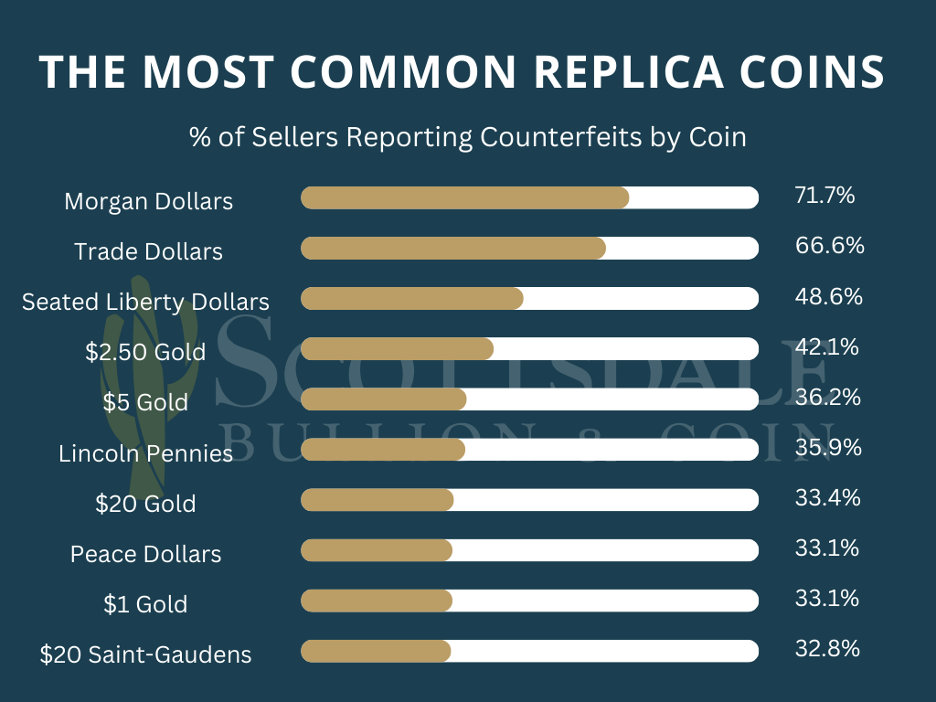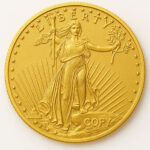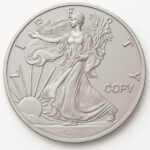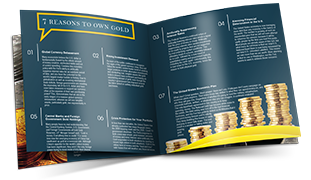The investment market is teeming with replica coins – high-quality copies of original, authentic coins. This imitation coinage is crafted to appear as close to the genuine article as legally possible.
This situation leaves many investors with a crucial question: How can you identify a replica coin?
Advances in minting technology, the involvement of foreign actors (notably from China), and deceptive sales tactics make it increasingly challenging to distinguish between real and fake coins.
However, there are effective steps investors can take to identify replicas. Implementing these strategies can save you hundreds, if not thousands, of dollars.
1. Pay close attention to commonly targeted coins.
According to the Anti-Counterfeiting Educational Foundation—the industry leader in replica coins—there are known fakes for every American coin minted since 1793.
This proliferation can make spotting a replica feel like searching for a needle in a haystack of needles!
Interestingly, counterfeiters target some coins more than others, providing investors with valuable insights into which coins are more likely to be faked.

If you’re investing in one of these commonly targeted coins, you should take extra steps to ensure it’s not counterfeit.
2. Check for a denomination or face value.
Official American precious metal coins are legal tender. This means authentic coins feature a denomination such as “ONE DOLLAR” in the case of the Morgan Silver Dollar or “$50” for the 1 oz Gold Buffalo.
These markings point to the face value of authentic coinage, although the inherent value of precious metals coins tends to be much higher. Investment-grade American coins often feature their denomination on the reverse side.
Replica coins, on the other hand, usually replace the coin’s face value with a product description like “.999 Fine Gold”, “Gold Proof”, or “Giant Proof”. Alternatively, imitation coins might omit this information since assigning a nominal value to a privately minted coin is illegal.
The lack of a denomination doesn’t mean a coin isn’t a worthwhile investment; it simply means it’s not legal tender and likely a replica.
3. Look for the word “copy.”
 One of the easiest ways to identify a replica coin is to check for the word “copy”. Under federal law, imitation coins are required to feature this information for clear identification as replicas.
One of the easiest ways to identify a replica coin is to check for the word “copy”. Under federal law, imitation coins are required to feature this information for clear identification as replicas.
The Hobby Protection Act states “any imitation numismatic item which is not plainly and permanently marked ‘copy’, is unlawful and is an unfair or deceptive act or practice in commerce under the Federal Trade Commission Act.”
 This law doesn’t require uniformity which means “copy” can be found in different colors, fonts, and sizes across replica coins. As long as the marking is permanent and visible, the imitation coin is compliant.
This law doesn’t require uniformity which means “copy” can be found in different colors, fonts, and sizes across replica coins. As long as the marking is permanent and visible, the imitation coin is compliant.
Here are some examples of different “copy” emblazons on replicas of the famous Saint-Gaudens Double Eagle to illustrate this variety:
A quick once-over should be enough to pinpoint a “copy” marking on a coin. However, not every producer of replica coins follows federal law, so a coin without this info shouldn’t automatically be assumed to be an original.
4. Avoid sales pitches with strategic buzzwords.
Sellers of replica coins have become adept at using strategic language to make their fake coins sound authentic or valuable without directly claiming to sell an original.
Some clever buzzwords to keep an eye out for include:
- Tribute
- Adaptation
- Reproduction
- Imitation
- Historically Accurate
- Museum Quality
- Antique Finish
- Facsimile
- Gold Plated
- Commemorative
When you come across these buzzwords in a sales pitch, you’re most likely looking at an ad for replica coins.
5. Keep an eye out for odd sizes and weights.
Under US law, it’s illegal to produce an exact copy of an official coin. To get around this counterfeiting obstacle, some sellers produce replica coins in slightly larger or smaller versions than the original.Terms such as “magnification” or “miniature” are usually dead giveaways of a coin’s inauthenticity. You can also compare a coin’s size with the official dimensions.
The US Mint offers an entire guide for Identifying Genuine U.S. Coins where genuine coin sizes are compared with common replica coins.
Odd weights are another common sign of replica coins. All government-minted coins must follow strict standards, ensuring all have the same weight.
You’ll only come across extremely minor weight variations in official coins due to wear and tear, although these differences are virtually undetectable.
Using a food scale or dedicated coin scale can help you determine whether a coin matches or misses the official weight for a particular coin.
6. Look closely at unreasonably good deals.
The old adage, “If something is too good to be true, it probably is,” rings especially true in the precious metals coin market. This principle serves as a handy razor for determining if a coin is a replica or the real deal.
Before making a purchase, compare the seller’s price with what similar coins are going for in the market. You can check third-party sites such as eBay and Amazon or e-commerce coin dealer sites.
If you notice a huge discrepancy between the deal you found and the average market price, it’s more likely you’ve found a replica rather than a once-in-a-lifetime deal. Approach suspiciously low-priced coins with extreme caution.
You’d be highly skeptical of a Ferrari being sold for the same price as an economy car, right? Investors need the same healthy amount of scrutiny when assessing coin prices.
7. Get a professional assessment.
In combination, these strategies can effectively help investors spot a replica coin. However, the most surefire way to differentiate the real from the fake is through a professional assessment.
Coin experts and precious metals dealers have the expertise, insights, and tools needed to accurately determine the authenticity of a coin. This professional input is crucial when making financial decisions, especially with a growing number of counterfeit coins.
The precious metals advisors at Scottsdale Bullion & Coin would be happy to give you an honest assessment to help you ascertain a coin’s value and originality. Contact us by calling toll-free at 1-888-812-9892 or by using our live chat function.


